No dig flower borders – easy, weed-free and brilliant
I’ve always wondered about ‘no dig flower borders’ for annuals, shrubs and perennials.
Not that I ever do much digging. But I wondered if the principles of no dig veg and no dig flower borders were the same. Was I doing the right thing by mulching my borders but not digging it in? What else do I need to know about no dig borders?
So I visited Charles Dowding, no dig guru and author of many books, including Organic Gardening, the Natural No Dig Way.

Visiting Charles Dowding to find out more about ‘no dig borders’ for flowers in middle-sized gardens.
Charles is known for his trials, carried out over around thirty years, comparing yields of dig and no dig vegetable beds. He runs workshops, writes books and has a fantastically successful YouTube channel. It’s all based at Homeacres, a three-quarters of an acre in Somerset.
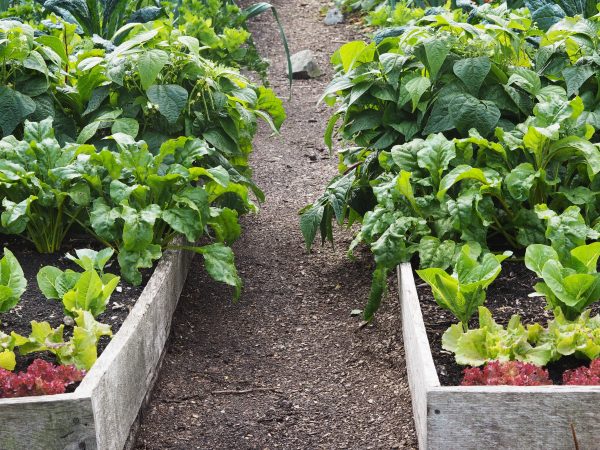
Charles always has a couple of ‘dig vs no dig’ beds. He grows exactly the same plants at the same time, and measures their yields. He also assesses how many weeds they have and how healthy they are. In this trial, the dug bed has far more weeds than the ‘no dig’ bed.
The basic principle of no dig gardening
Charles maintains that digging the soil destroys its structure. If you lay a few inches of compost or manure on top of the soil once a year, the worms and micro-organisms will dig it in naturally, he explains. He weeds manually or with a hoe, just on the top inch or so of earth. For perennial weeds, such as bindweed or couch grass, he covers the whole bed in light-excluding mulch so that the roots die.
The principles are the same for no dig flower borders as they are for no dig veg beds.
He plants seedlings with a dibber, dropping them straight into the hole without disturbing the soil around them. His trials show that undisturbed soil, which is fed with compost, will be firm, easy to plant into, will have fewer weeds and better yields of vegetables.
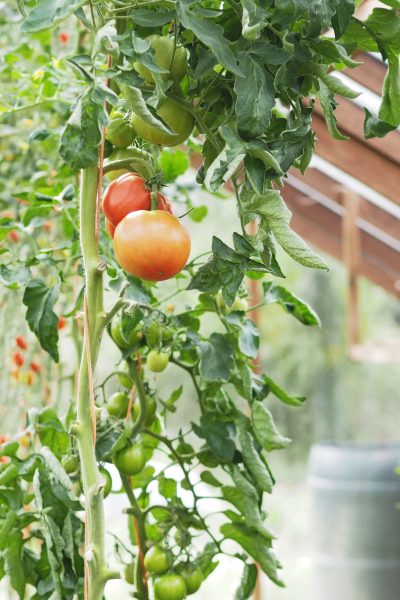
Charles’ extraordinarily healthy no dig tomatoes, growing in his greenhouse where they are underplanted with marigolds.
It is a simple and easy way to garden – you can find out more about it in Organic Gardening – The No Dig Way. You’ll find lots of useful information about when and how to plant each different vegetable. And it also helps you make the most of a small plot by inter-cropping and successional cropping.
I was sent a review copy by the publishers, and can highly recommend it. It’s packed with useful growing information, how to deal with pests and diseases and the results of Charles’ experiments. This is not only about ‘no dig’ but also about whether you really need to do crop rotation, and other aspects of growing veg.
(note: Links to Amazon are affiliate links. If you buy, I may get a small fee but it won’t affect the price you pay. Other links are not affiliate.)
No dig for flower borders
And he says the same principles apply to no dig flower borders with annuals, perennials and shrubs. At Homeacres there are flowers everywhere, from ‘companion plantings’ of marigolds to purely ornamental cosmos, zinnias and roses.
‘The main difference between no dig flower borders and no dig vegetable borders is that vegetables are very hungry feeders,’ he says. ‘So I’d use less compost when mulching a border with shrubs and perennials. And in a vegetable garden or allotment, you may be growing more than one crop, which you won’t do in a flower border with perennials and shrubs.’
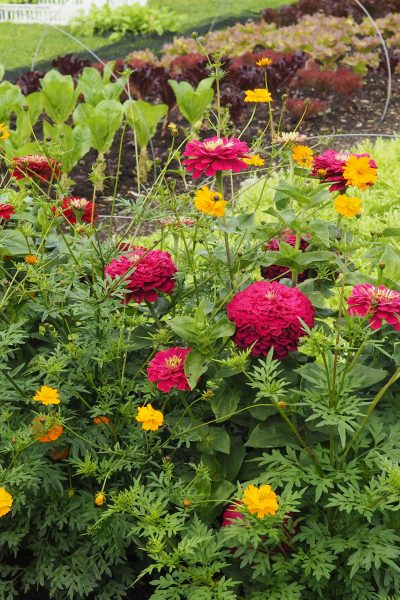
No dig flower borders are brilliantly healthy – zinnias and marigolds amongst the lettuces at Homeacres.
I asked him if annual flowers might use up more nutrients in the soil than perennials? After all, they are dead-headed to produce more flowers and they can be grown successionally.
‘It’s a fair point,’ he says. ‘But even annual flowers won’t need as much compost as vegetables, because they are usually smaller and their growth is less strong.’
(If you’re interested in growing annuals from seed, see this post on Sowing seed – expert tips for more flowers and better germination.’)
Some people think that no dig means using more compost, and that it will be ‘too rich’ for flowers. But Charles says that it doesn’t. ‘People only think it’s more because they can see the compost lying on top. In the UK, there are now huge numbers of professional no dig flower growers. I’ve never heard any of them comment that the no dig method makes it too rich for flowers.’
Clearing no dig flower borders with bad perennial weeds
What if you have a border that is really badly affected by perennial weeds?
Charles uses the no dig method to clear borders of perennial weeds, such as couch grass, bindweed and ground elder. He advises starting around February. Dig up your plants and pot the ones you want to keep, carefully picking all the strands of perennial weed root out of their root ball.
Once the bed is clear, cover it with a light-excluding mulch. First add a layer of compost, then add horticultural plastic or cardboard on top. If you use cardboard, it will rot down and curl up, so you’ll need to replace it from time to time. (Some people use old carpet.)
By about the end of June, some perennial weeds, such as buttercup and dandelion, will have given up trying to grow. If you’re prepared to lose one bed for a whole summer, keep it covered until August to get rid of couch grass weeds.
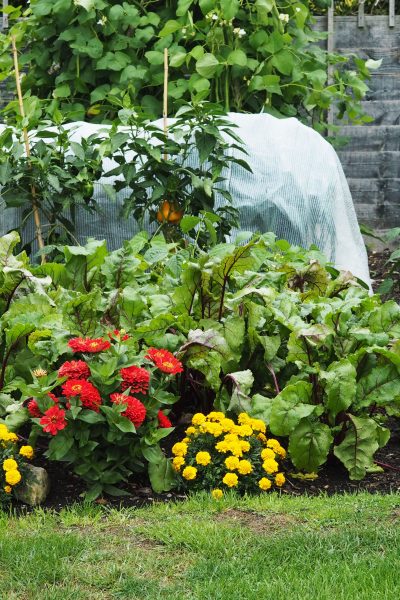
Charles Dowding has a 25 sq metre/270 sq ft patch, where he trials growing veg in a typical small garden. It’s divided into three beds, each cropping an average of four different vegetables, plus some flowers.
You can find more weeding tips in this post The no-nonsense guide to weeding your garden easily.
Then keep a watchful eye
However, it takes bindweed roots several years to die, he explains. As it’s unlikely you’ll want to keep your border covered for that long, he advises checking it once a week after re-planting for any emerging bindweed. Carefully pull out as much as possible with a trowel. Roots do come out more easily in a well-mulched border. He has completely rid a large bed of bindweed in this way.
I have one large bed that is heavily infested with bindweed. So I’m thinking of doing exactly this. I won’t even have to dig up any plants as they have been completely smothered by the fiendish vine.
But I’ll mulch it and cover it with plastic until the end of next summer. It’s at the back of the garden, so I won’t miss it as much as I would miss the main big bed in front of the kitchen window.
Note: 5 years later: I covered the border with horticultural plastic for 18 months. Then I re-planted it with comfrey. Comfrey can be invasive, but it has out-competed the bindweed.
And if the comfrey gets too much, I can pull it out and make natural homemade fertiliser with it.
Annual weeds and no dig flower borders
‘You want to be weeding out annual weeds almost before you see them,’ he says. That means starting to look out for the very first weed seeds emerging in February. Don’t wait until you feel overwhelmed by weeds. The fact that weeds are growing is also a sign that you can start planting seeds, too.
To weed without disturbing the soil, Charles runs a hoe lightly over the surface. This breaks off the emerging leaves from their roots. The weed seedlings die on the surface of the bed. There isn’t even any no need to dispose of them.
See this on video:
You can see how Charles plants, hoes and more views of Homeacres on this video.
One of the main benefits of ‘no dig’ is that you get fewer annual weeds. When you turn the soil, weed seeds are brought to the surface and they germinate. If you don’t dig the soil, the weed seeds stay underground. And if you can get rid of the annual weeds that do grow, early enough in their cycle, you will soon have surprisingly weed-free soil.
Charles says the main difference between his current ‘no dig’ and ‘dig’ bed is that the ‘no dig’ bed has far fewer weeds. He uses a Dutch oscillating stirrup hoe (see the video).
I rely on self-seeding plants in my borders, so I will have to balance my love of these with my desire to be more weed-free. After all, weeds are just self-seeding plants that you don’t want.
Don’t disturb the soil when planting
I watched Charles plant out a tray of spinach seedlings. He made holes with a dibber, and dropped the seedlings straight into the hole. He finds seedlings are more likely to succeed than sowing seed into the soil. I agree – I have almost never managed to grow anything from seed when sown directly into the soil. Plant seed in trays or modules first, then transfer once the first secondary leaves have emerged.
The same principle applies to annual flower seeds, such as cosmos, zinnias and sunflowers, in no dig flower borders. Grow your seeds in modules or trays, then plant out with a dibber.
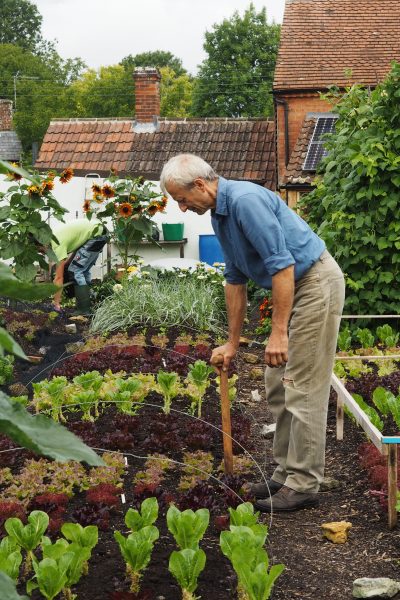
Charles using a wooden dibber to make holes that are exactly the size of seedling roots. You can plant annual flower seedlings into borders in exactly the same way.
If you are planting shrubs or perennials in no dig flower borders, Charles advises digging a hole big enough to hold the rootball of the plant ‘but no bigger’. He doesn’t think that loosening the soil around the area helps the plant grow at all. He believes plants grow better in firm soil.
Can you walk on no dig borders?
I am always diving into my borders to dead-head or pull out a weed. So I was worried that I was damaging the soil structure. But Charles says not: ‘Healthy soil is firm enough to walk on. One of the beauties of no dig gardening is that you can walk onto your beds to work without damaging the soil structure.’
In fact, we were even told to park on the grass when we arrived.
And when we left, Mr Middlesize asked Charles if he could guide us out when reversing. ‘Oh, just drive across the lawn,’ said Charles. Mr Middlesize was quite traumatised. ‘I’ve never met anyone who let you drive across the lawn before,’ he said, as he did a three-point-turn on the grass. I explained that firm, healthy soil could cope with it.
Charles Dowding’s courses and books
You can learn more about no dig gardening with Charles Dowding’s courses, talks and books, including Organic Gardening, The Natural No Dig Way. Books can be bought online, in bookshops or from charlesdowding.co.uk
Or catch up with his excellent YouTube channel on growing organic no dig vegetables. It’s a very clear and informative YouTube channel, and I’ve often consulted it to find out more about how to grow veg.
While you’re there – do subscribe to the Middlesized Garden YouTube channel too. My ambition is to be equally clear and informative about gardening in a middle-sized garden, with tips, ideas and inspiration for those of us whose gardens are…well, not very big.
Pin to remember no dig for flower borders
And join us on The Middlesized Garden blog. See here for a free weekly email with more gardening tips, ideas and inspiration. Thank you!
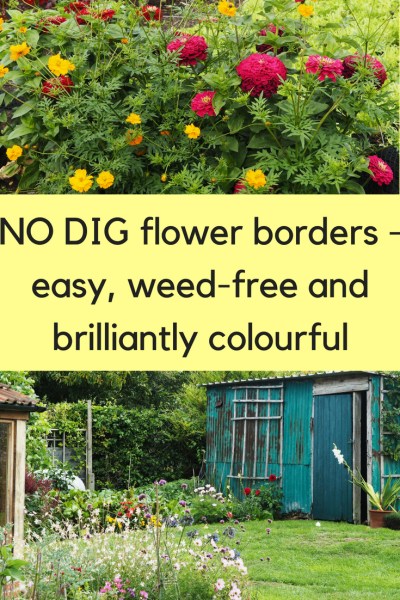
























Great post. I do no dig on my veg and was planning to try it on my flower borders as I couldn’t see how it wouldn’t work just as well but wasn’t sure- this is a great encouragement! Thank you so much
That was what I thought! I did ‘no dig’ because I had a bad back, but thought I had better find out if it was different for flowers.
One thing I don’t understand is how you do this with an already established border, I have far to many bulbs to dig up. Will the still come up if I layer with compost, or will they die along with the weeds?
All the perennial plants, such as bulbs, which die away over winter and then come back the following year, will come up through the compost. In fact, perennial weeds will also come up through compost, but they will be easier to pull up. Layering the compost on the ground will cover the annual weed seeds, so you will get fewer weeds. When you dig soil, you bring annual weed seeds to the surface. They then germinate, which is why digging gives you more weeds and layering compost on soil without digging gives you fewer weeds. But there will always be some weeds.
I am a completely novice gardener but used the no dig method to plant bulbs in my new medium sized garden. It worked and I am very keen to know more of this method. Thank you for sharing.
Thank you!
This is a brilliant introduction to no dig gardening. Having to deal with fewer annual weeds sounds like a huge advantage. Besides, it does make so much sense not to destroy the structure of your soil. Thanks for sharing!
Thank you!
I have heard of this concept but haven’t tried it yet. I’ll be interested to try it on one of my flower boarders to test things out. Thank you for sharing this Alexandra!
Hope it goes well – it makes alot of sense and Charles’ flowers look very happy on it.
Big fan of no-dig. I have mulched for two years now. I will never be rid of bindweed though, it comes in from.next door. I also refer to his youtube channel, although,for reasons best known to me I ignored his advice and sowed direct. Big problems.. i shall sow in modules from now on…
Me, too, definitely. I thought there was something wrong with me that I couldn’t sow seeds directly in the ground, so it’s a huge relief to find that more experienced gardeners than me also don’t think it works!